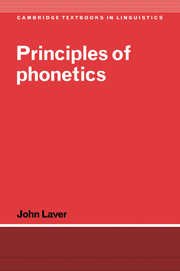Book contents
- Frontmatter
- Contents
- List of figures
- List of tables
- Preface
- Acknowledgements
- Introduction
- PART I General concepts
- PART II The analytic framework
- PART III Initiation and phonation
- PART IV Linear segmental analysis
- PART V Articulatory co-ordination and phonetic settings
- PART VI Temporal, prosodic and metrical analysis
- 14 The temporal organization of speech: segmental duration
- 15 The prosodic organization of speech: pitch and loudness
- 16 The metrical organization of speech: stress, syllable weight, prominence and rhythm
- 17 The temporal organization of speech: continuity and rate
- PART VII Principles of transcription
- PART VIII Conclusion
- Envoi
- Appendix I The phonetic alphabet of the International Phonetic Association
- Appendix II Index of languages
- References
- Index of names
- Subject index
16 - The metrical organization of speech: stress, syllable weight, prominence and rhythm
Published online by Cambridge University Press: 05 June 2012
- Frontmatter
- Contents
- List of figures
- List of tables
- Preface
- Acknowledgements
- Introduction
- PART I General concepts
- PART II The analytic framework
- PART III Initiation and phonation
- PART IV Linear segmental analysis
- PART V Articulatory co-ordination and phonetic settings
- PART VI Temporal, prosodic and metrical analysis
- 14 The temporal organization of speech: segmental duration
- 15 The prosodic organization of speech: pitch and loudness
- 16 The metrical organization of speech: stress, syllable weight, prominence and rhythm
- 17 The temporal organization of speech: continuity and rate
- PART VII Principles of transcription
- PART VIII Conclusion
- Envoi
- Appendix I The phonetic alphabet of the International Phonetic Association
- Appendix II Index of languages
- References
- Index of names
- Subject index
Summary
The previous chapter described the prosodic structure of speech in terms of melody and loudness. Any musical phrase is characterized not only by these factors, however, but also by its metrical structure - the grouping, accentuation and rhythm of the delivery of its component parts. Continuing this musical metaphor, this chapter considers the metrical structure of speech in terms of the relationships between its syllables, stress and rhythm.
The metrical organization of speech is the most complex of all the different levels to analyse, in that its temporal structure integrates facets of all four basic dimensions of speech - quality, duration, loudness and pitch. In the previous chapter, it was said that ‘Other things being equal, one syllable is more prominent than another to the extent that its constituent segments display higher pitch, greater loudness, longer duration or greater articulatory excursion from the neutral disposition of the vocal tract.’ This description tacitly compares two syllables of the same phonological structure. Where one of two otherwise identical syllables is made more prominent than the other by an exaggeration of the value of one or more of the phonetic parameters of pitch, loudness, duration or quality in this way, the more prominent syllable can be said to receive more stress. In this definition, phonetic stress is a gradient phenomenon, and the phonetic realization of any syllable can be said to show a greater or less degree of stress relative to the manifestation of some other syllable.
- Type
- Chapter
- Information
- Principles of Phonetics , pp. 511 - 533Publisher: Cambridge University PressPrint publication year: 1994



